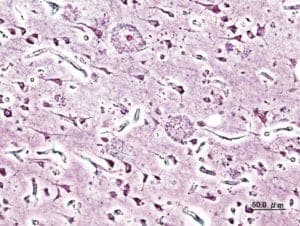A sweet tooth can cause more than just weight gain — scientists have now linked excess sugar to Alzheimer’s disease.
Scientists from the University of Bath in Australia have been able to link excess sugar to Alzheimer’s disease in a recent study. Sugar breaks down in a reaction known as glycation, and its byproducts can cause damage to a cell.

“Excess sugar is well known to be bad for us when it comes to diabetes and obesity, but this potential link with Alzheimer’s disease is yet another reason that we should be controlling our sugar intake in our diets,” co-author Omar Kassaar told Medical Xpress.
The scientists discovered that an enzyme known as macrophage migration inhibitory factor, or MIF, is damaged during glycation. Jean van den Elsen, an author with the study, said MIF would normally be seen during the body’s immune response to a buildup of irregular proteins within the brain.
“We think that because sugar damage reduces some MIF functions and completely inhibits others that this could be a tipping point that allows Alzheimer’s to develop,” van den Elsen said.
Related: Artificial Sweeteners Are the New Sugar Fix for Kids
Brain cell samples from individuals diagnosed with severe and mild Alzheimer’s, along with a group of samples without Alzheimer’s, were studied. A total of ten samples were analyzed, and several glycated proteins were found, including MIF.
The MIF enzyme changes as it’s affected by glucose within the brains of those who are in the early stages of Alzheimer’s, van den Elsen said. Glycation of MIF only increases as Alzheimer’s disease advances.
Glucose is already known to adversely change the proteins within the brain, and it’s a characteristic of hyperglycemia, or an abnormally high blood glucose level. Hyperglycemia is most directly linked with diabetes.
MIF is involved in regulating insulin, and the damage done to the enzyme by glucose supports the suggestion that individuals with diabetes are at a higher risk for developing Alzheimer’s. Damaged MIF was found in both early and late stages of Alzheimer’s, the authors wrote.
Related: Immunotherapy Could Be the Next Step to Preventing Alzheimer’s
“We also show that these modifications can develop within a matter of days and can affect MIF activity and degradation long before the formation of irreversible advanced glycation endproducts,” the authors said.

In 2016, an estimated 5.4 million people had Alzheimer’s disease. The Alzheimer’s Association estimated that by 2050, the number of people age 65 and older with Alzheimer’s could triple to a projected 13.8 million without the intervention of medical breakthroughs.
Alzheimer’s and other forms of dementia were estimated to cost the U.S. $236 billion in 2016. The disease is also the sixth leading cause of death within the U.S. Rob Williams, an author with the study, said discovering the MIF damage could mean progress for dementia patients.
“Knowing this will be vital to developing a chronology of how Alzheimer’s progresses and we hope will help us identify those at risk of Alzheimer’s and lead to new treatments or ways to prevent the disease,” Williams said.
The study was published in Scientific Reports and was funded by the Dunhill Medical Trust. Human brain tissue was provided through Brains for Dementia Research.
Tori Linville is a freelance writer and editor from Clarksville, Tennessee. When she isn’t writing or teaching, she’s faithfully watching her alma mater, the University of Alabama, dominate the football field.


![How To: ‘Fix’ Crepey Skin [Watch]](https://cdn.vitalupdates.com/wp-content/uploads/2017/05/bhmdad.png)












